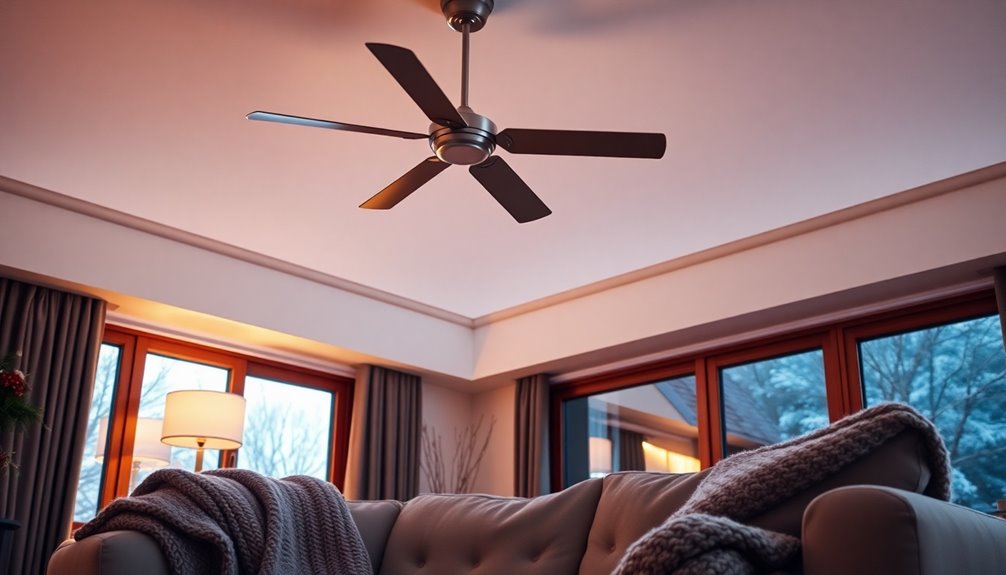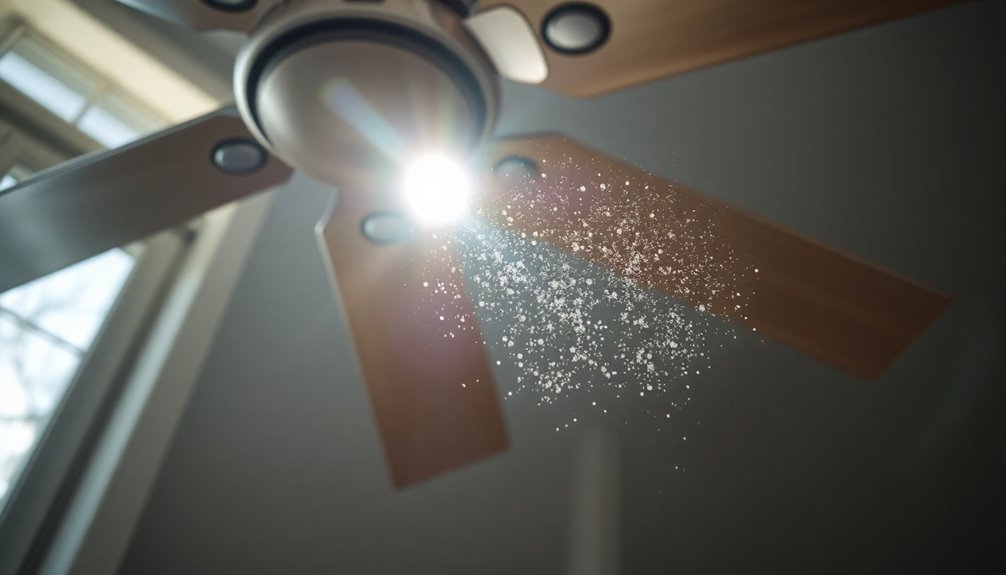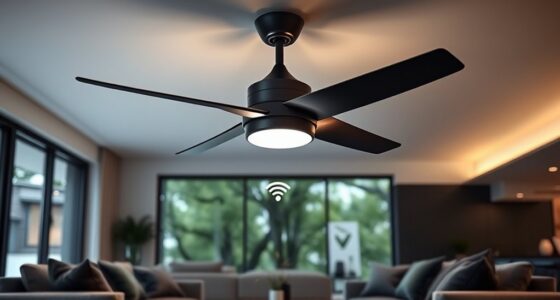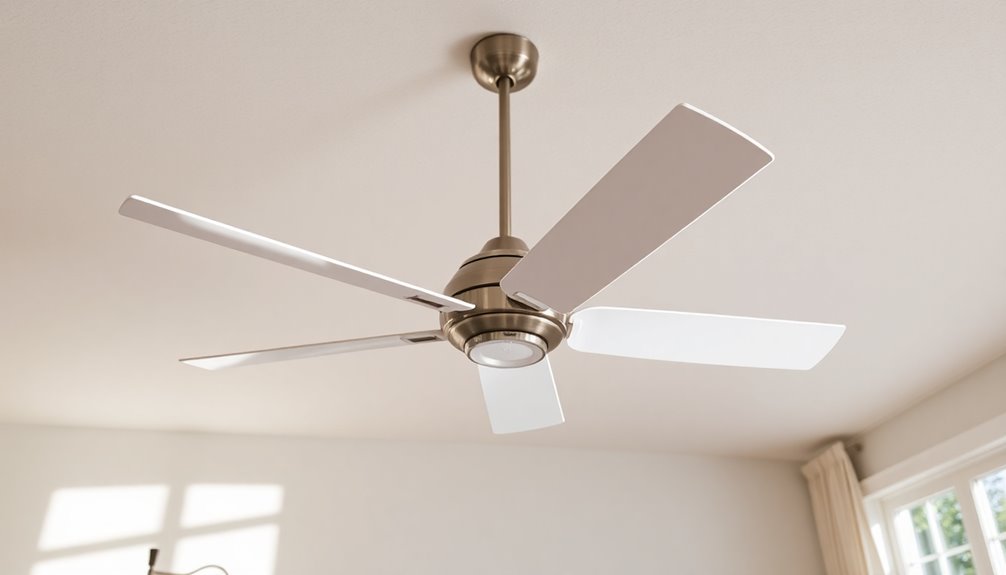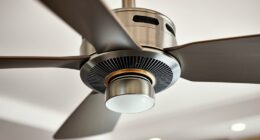Ceiling fans gained popularity in American homes during the early 1900s. Initially, they were luxury items aimed at affluent buyers. However, by the 1950s, they transformed into essential cooling solutions as disposable incomes rose. Despite facing competition from air conditioning, a resurgence happened in the 1970s when energy crises shifted consumer focus back to cost-effective cooling alternatives. By now, ceiling fans not only help you stay cool but also enhance your home's decor and energy efficiency. Want to know more about their evolution and modern features? There's plenty more to discover!
Key Takeaways
- Ceiling fans gained popularity in the early 1900s, initially marketed as luxury items for affluent homes.
- The 1920s saw ceiling fans become standard fixtures in residential homes, enhancing their appeal with variable-speed motors.
- Post-WWII, increased disposable income led to a resurgence in ceiling fan adoption across American households.
- The 1970s energy crises prompted renewed interest in ceiling fans as cost-effective cooling alternatives to air conditioning.
- By the 1980s, sales surged into millions, solidifying ceiling fans as essential cooling solutions, especially in hot climates.
Origins of Ceiling Fans

In the 17th century, the origins of ceiling fans can be traced back to India, where they were known as punkahs. These early ceiling fans were manually operated, requiring servants to pull a cord to create airflow in hot climates.
The history of ceiling fans took a transformative turn in 1882 when Philip Diehl invented the first electrically powered ceiling fan. By combining a sewing machine motor with a fan design, he created a product that revolutionized indoor cooling.
Diehl's innovative ceiling fan design received a patent in 1889, prompting mass production and widespread adoption in the United States. Initially, ceiling fans primarily served commercial spaces like factories and restaurants, providing relief from heat.
However, by the 1920s, they became increasingly popular in residential settings, as homeowners sought energy-efficient solutions for comfort. The introduction of variable-speed motors in the 1920s further enhanced their appeal, allowing for customizable airflow and improved efficiency.
Today, ceiling fans are a staple in many homes, blending functionality with style, making them an essential part of modern living.
Early Adoption in America

How did ceiling fans shift from commercial spaces to American homes? The journey began in the early 1900s, when electric ceiling fans, first invented by Philip Diehl in 1882, started gaining traction. Initially, ceiling fans targeted affluent buyers, but by the 1920s, they became popular for residential use, thanks to improved functionality with variable-speed motors.
| Year | Developments | Impact |
|---|---|---|
| Early 1900s | First marketed for homes | Targeted affluent buyers |
| 1920s | Introduction of variable-speed motors | Enhanced fan functionality |
| Post-WWII | Resurgence in popularity | Increased disposable income |
| 1950s | Common in residential homes | Became a standard fixture |
Following World War II, the combination of rising disposable income and a growing preference for comfort made ceiling fans a staple in many households across the United States. Their ability to provide cooling relief and energy efficiency solidified their place as a popular home accessory. You can see how ceiling fans evolved from luxury items to essential household fixtures, shaping the way you experience comfort in your home.
Decline With Air Conditioning

The 1950s marked a turning point for cooling solutions in American homes, as air conditioning gained immense popularity. Consumers quickly shifted their preferences toward the more effective cooling provided by air conditioning units.
In just a few years, production skyrocketed from 194,000 units in 1950 to 1.35 million in 1954, illustrating how quickly this trend took hold. As central air systems made their way into homes by the 1960s, the decline of ceiling fans became even more pronounced.
While ceiling fans remained an affordable cooling option, especially for families in hotter regions, they struggled to compete with the comfort and convenience of air conditioning. The booming air conditioning industry overshadowed ceiling fans, resulting in a significant reduction in their market presence.
Many consumers opted for the powerful cooling effects of air conditioners, leading to a stark decline in ceiling fan popularity. Despite their practicality and lower cost, ceiling fans found themselves relegated to a secondary role in the cooling landscape of American homes during this era.
The rise of air conditioning fundamentally changed the way people approached cooling solutions, leaving ceiling fans to fade into the background.
Resurgence in Popularity

A notable shift occurred in home cooling preferences during the 1970s as energy crises prompted many to seek cost-effective alternatives to air conditioning. This led to a renewed interest in ceiling fans, which became a popular cooling alternative. By 1980, sales surged from hundreds of thousands to millions, reflecting their resurgence in popularity.
Consumers gravitated toward ceiling fans not just for their affordability but also due to modern designs that blended seamlessly with contemporary decor. These fans offered increased efficiency, appealing to those focused on energy conservation.
In regions with hot climates, ceiling fans became essential, allowing homeowners to raise thermostat settings while still enjoying comfort.
Despite a decline in popularity in the mid-20th century, global demand for ceiling fans remained robust. As people recognized their ability to reduce energy bills and enhance indoor air circulation, ceiling fans reclaimed their place in homes across the world.
This shift underscored the importance of finding practical solutions for cooling, reinforcing the idea that ceiling fans are a smart choice for anyone looking to balance comfort and energy efficiency.
Modern Features and Benefits

Ceiling fans have evolved greatly, offering modern features that enhance both comfort and efficiency in today's homes. With their ability to create a wind-chill effect, you can feel 6-8 degrees cooler without changing the actual air temperature. This not only boosts your comfort but also helps reduce energy costs.
Many ceiling fans now utilize advanced motor technology and have increased blade counts, which notably improve energy efficiency and air circulation. Additionally, the integration of light fixtures allows these fans to serve dual purposes, providing both illumination and cooling in a single unit.
Here's a quick overview of modern ceiling fan features:
| Feature | Benefit | Lifespan |
|---|---|---|
| Advanced Motor Tech | Improved energy efficiency | 10 to 15 years |
| Wind-Chill Effect | Enhanced comfort | |
| Integrated Light | Dual purpose: light & cooling | |
| Decorative Elements | Versatile design for any decor |
With a lifespan averaging 10 to 15 years, investing in ceiling fans is cost-effective. They not only provide ongoing air circulation but also add style to your space, making them essential modern features in any home.
Global Trends and Preferences

As global temperatures rise and energy costs fluctuate, many homeowners are turning to ceiling fans as a practical and stylish solution for climate control. This trend isn't just a local phenomenon; it reflects a broader global preference.
In regions with hot climates, like India and the Middle East, ceiling fans are often the go-to choice for those seeking a cost-effective alternative to air conditioning, particularly in resource-limited areas.
The energy crisis of the 1970s marked a pivotal moment for ceiling fans, boosting their popularity as people sought economical cooling options amidst soaring energy costs. Innovations during that decade, like the collaboration between Greaves Cotton and Crompton Parkinson, resulted in energy-efficient fans that consume less than 100 watts per hour.
This development not only made ceiling fans more appealing but also aligned with the growing consumer awareness around energy conservation.
Today, as you consider your climate control options, ceiling fans stand out as an integral part of modern living. Their ability to combine style with functionality, along with their energy-efficient electric motors, makes them a smart choice for any home aiming to balance comfort and sustainability.
Frequently Asked Questions
When Did Ceiling Fans Become Common?
Ceiling fans became common in homes during the 1920s, as electric models became more accessible.
You'll find that their popularity surged due to advancements in technology and design, making them an attractive cooling option.
Before this, some homes used manual fans, but the introduction of electric fans changed everything.
Were There Ceiling Fans in the 70S?
Yes, there were ceiling fans in the 70s, and they became quite popular during that decade.
As energy prices rose, you likely turned to ceiling fans as a cost-effective way to cool your home.
With advancements in design and efficiency, these fans offered a stylish alternative to air conditioning, allowing you to save on electricity bills.
You probably noticed more homes embracing ceiling fans as essential cooling solutions during that time.
What Percentage of Homes Have Ceiling Fans?
About 75% of homes in the United States have at least one ceiling fan installed.
If you live in a hotter climate, like the southern U.S. or parts of India, you might find that over 90% of homes use them for cooling.
Many homeowners prefer ceiling fans due to their energy efficiency and cost-effectiveness compared to air conditioning, making them a smart choice for keeping your space comfortable during warmer months.
Why Do American Homes Have Ceiling Fans?
Ceiling fans bring a breath of breezy bliss to your home.
You'll find they're popular for several reasons: they effectively circulate air, keeping spaces cool and comfortable.
They also cut down on energy costs, allowing you to raise your thermostat while still feeling fresh.
Plus, with a variety of stylish designs, they add flair to your decor.
Conclusion
In the dance of home comfort, ceiling fans have twirled from obscurity to prominence and back again, proving their timeless charm. As you embrace modern innovations and eco-friendly designs, these elegant fixtures whisper cool breezes into your space, reminding you of the simple joys of airflow. Just like a gentle summer breeze, they're here to stay, blending style with function in a world where comfort reigns supreme. So, let your ceiling fan spin and elevate your every moment.

